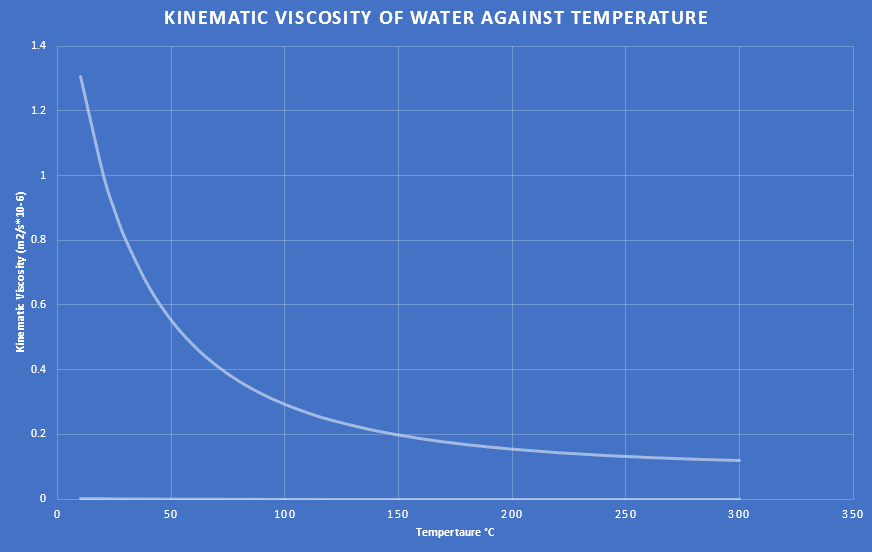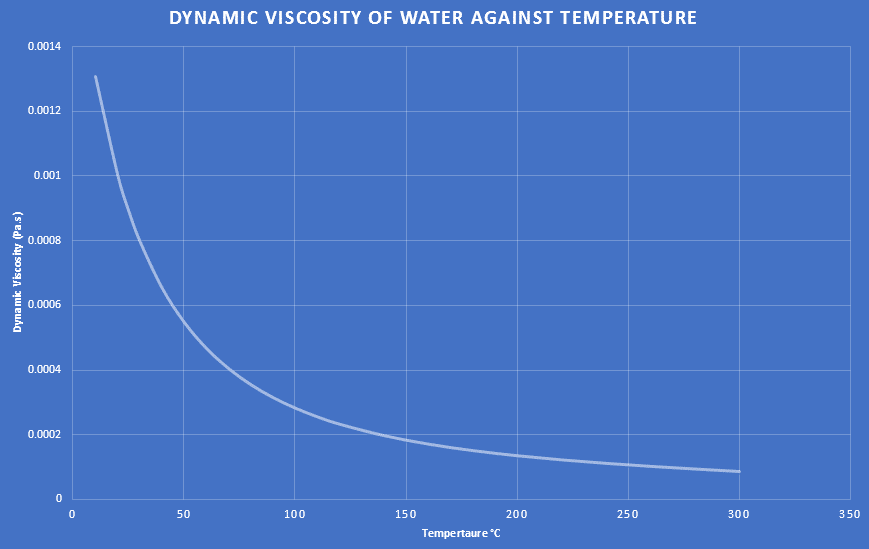Properties of Water
Table of Contents
What is the Viscosity of Water?
The viscosity of water or any fluid is defined as the measure of resistance to deformation at a given rate by shear stress or tensile stress. We can think of this practically when imagining pouring water and honey into a container. The water flows much more easily and the honey will take its time forming the shape of the container.
We can imagine it as the ‘thickness of a fluid’ when we consider viscosity. Therefore, oil and honey have a higher viscosity than water.
Dynamic viscosity of water
The dynamic viscosity of water at 20 °C is below:
- 0.0010016 N s/m2
- 1.00160 cP or mPa s
- 2.0919 Ibf s/ft2 x 10-5
Kinematic viscosity of water
The kinematic viscosity of water at 20 °C is below:
1.0035 m2/s x 10-6 or cSt
Kinematic and Dynamic Water Viscosity Tables
| Temperature | Dynamic viscosity | Kinematic viscosity | ||
| [°C] | [Pa s], [N s/m2] | [cP], [mPa s] | [lbf s/ft2*10-5] | [m2/s*10-6], [cSt]) |
| 10 | 0.001306 | 1.306 | 2.7276 | 1.3065 |
| 20 | 0.0010016 | 1.0016 | 2.0919 | 1.0035 |
| 25 | 0.00089 | 0.89004 | 1.8589 | 0.8927 |
| 30 | 0.0007972 | 0.79722 | 1.665 | 0.8007 |
| 40 | 0.0006527 | 0.65272 | 1.3632 | 0.6579 |
| 50 | 0.0005465 | 0.5465 | 1.1414 | 0.5531 |
| 60 | 0.000466 | 0.46602 | 0.9733 | 0.474 |
| 70 | 0.0004035 | 0.40353 | 0.8428 | 0.4127 |
| 80 | 0.000354 | 0.35404 | 0.7394 | 0.3643 |
| 90 | 0.0003142 | 0.31417 | 0.6562 | 0.3255 |
| 100 | 0.0002816 | 0.28158 | 0.5881 | 0.2938 |
| 110 | 0.0002546 | 0.25461 | 0.5318 | 0.2677 |
| 120 | 0.000232 | 0.23203 | 0.4846 | 0.246 |
| 140 | 0.0001966 | 0.19664 | 0.4107 | 0.2123 |
| 160 | 0.0001704 | 0.17043 | 0.3559 | 0.1878 |
| 180 | 0.0001504 | 0.15038 | 0.3141 | 0.1695 |
| 200 | 0.0001346 | 0.13458 | 0.2811 | 0.1556 |
| 220 | 0.0001218 | 0.12177 | 0.2543 | 0.1449 |
| 240 | 0.0001111 | 0.11106 | 0.232 | 0.1365 |
| 260 | 0.0001018 | 0.10181 | 0.2126 | 0.1299 |
| 280 | 0.0000936 | 0.09355 | 0.1954 | 0.1247 |
| 300 | 0.0000859 | 0.08586 | 0.1793 | 0.1206 |


Units of Water Viscosity
The Units of water viscosity can be be expressed in SI units, CGS units or Imperial units.
The SI unit for dynamic water viscosity is Newton second per square meter (N s2/m and can be expressed in Pascal-second (Pa s) as well. The CGS units refer to poise (P, or g cm-1s-1 = 0.1 Pa s) and is commonly expressed as centipoise.
The SI unit for water kinematic viscosity is square meter per second (m2/s). The CGS unit is called “strokes” (St or cm2s-1 = 0.0001m2 s-1) 1 cSt = 1 mm2s-1 = 10-6m2s-1
Does temperature affect the viscosity of water?
Yes, the temperature does affect the viscosity of water. The water viscosity decreases as the temperature increases. The water molecules have less kinetic energy to move at lower temperatures meaning the water does not flow as easily (water starts to turn to ice) and the kinetic energy increases as the temperature increases, which decreases the viscosity.
Other Useful properties of water
- The density of water is approximately 1g/m3 (1 gram per cubic centimeter) or 62 Ib/cu ft (pounds per cubic feet) or 1000 kg/m3 (kilograms per cubic meter) at a temperature of 4°C (39.2 °F)
- The specific heat of water is 4182 J/kg°C.
